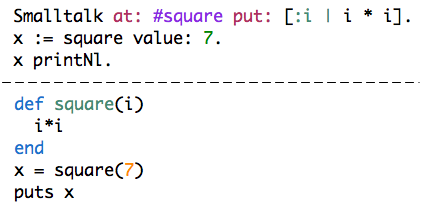Ruby’s Top Self Object

Creating functions without a class is
awkward in Smalltalk, but simple in Ruby.
Much of Ruby’s implementation of objects and classes is modeled after Smalltalk, one of the original object oriented languages first built in the late 1960s. Just like with Smalltalk, Ruby’s Object class is the root of your program’s class hierarchy, and all Ruby classes are instances of the Class class. Smalltalk blocks and Ruby blocks also both support using anonymous functions as closures.
But in one interesting way Ruby and Smalltalk differ. Ruby allows you to define simple functions at the top level scope. This enables Ruby to serve as a scripting language. Using Ruby, it’s very easy to combine a few functions together in a small script to accomplish some simple command line task. At the same time, Ruby’s has Smalltalk’s sophisticated OO design at the ready, waiting for you to use it. When your script gets a bit more complex, you can easily turn it into a more organized, object oriented program.
How does Ruby do this? Before your script starts to run, Ruby automatically creates a hidden object known as the top self object, an instance of the Object class. This object serves as the default receiver for top level methods. Today we’ll see how this object – the object we didn’t even know we were using – allows us to write simple functions in an object oriented language.
Read the full article on sitepoint.com.

